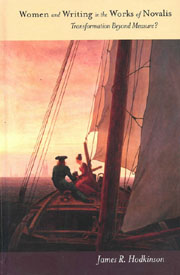Book contents
- Frontmatter
- Contents
- Acknowledgments
- Abbreviations of Major Primary Works Cited
- Typological Conventions in Novalis: Schriften
- Introduction
- 1 Writing in Context: Romanticism, Gender, and the Case of Novalis
- 2 Writing about Women, 1795–99
- 3 Esteem and the Epistolary: Hardenberg and Women of Letters
- 4 Music and the Manifold of Voices: The Subject and the Theory of Polyphony, 1797–99
- 5 From Music to Metamorphosis: Women's Role and Writing in Heinrich von Ofterdingen, 1798–1801
- 6 “Freyes Fabelthum”: The Poetic Construction of Gender in Hardenberg's Religious Writing
- Conclusion: Progression, Reaction, and Tension in Hardenberg's Gender Writing
- Works Consulted
- Index
2 - Writing about Women, 1795–99
Published online by Cambridge University Press: 05 February 2013
- Frontmatter
- Contents
- Acknowledgments
- Abbreviations of Major Primary Works Cited
- Typological Conventions in Novalis: Schriften
- Introduction
- 1 Writing in Context: Romanticism, Gender, and the Case of Novalis
- 2 Writing about Women, 1795–99
- 3 Esteem and the Epistolary: Hardenberg and Women of Letters
- 4 Music and the Manifold of Voices: The Subject and the Theory of Polyphony, 1797–99
- 5 From Music to Metamorphosis: Women's Role and Writing in Heinrich von Ofterdingen, 1798–1801
- 6 “Freyes Fabelthum”: The Poetic Construction of Gender in Hardenberg's Religious Writing
- Conclusion: Progression, Reaction, and Tension in Hardenberg's Gender Writing
- Works Consulted
- Index
Summary
Before Writing
IT WAS THE PHILOSOPHY he read, especially Johann Gottlieb Fichte's Wissenschaftslehre, that formed the theoretical basis of Hardenberg's mature work. Hardenberg met Fichte personally for the first time in early summer 1795 in the house of Immanuel Niethammer in Jena. By then Fichte had already won his reputation as a philosopher, having published several treatises in the early 1790s, followed by the first full version of the Wissenschaftslehre between 1794 and 1795, and having been awarded a chair at the university of Jena in the same year. By the time of their meeting, Hardenberg had read Kant closely and was becoming increasingly interested in Fichte, having attended his lectures at the university. Friedrich Hölderlin was also present, and the two young poets and the philosopher seem to have had much to talk about that evening. An oft-cited passage from Niethammer's diary bears witness to this: “[Es wurde] viel über Religion gesprochen und über Offenbarung und daß für die Philosophie hier noch viele Fragen offen bleiben” (N II, 31). Hardenberg's formal study of Fichte began, perhaps spurred on by the meeting, in November 1795 and lasted, in sustained written form, for the best part of a year; quite remarkably, he pursued it despite working full time as a civilservice secretary in Tennstedt. By the time he wrote to Friedrich Schlegel on 5 September 1797, informing him of another visit to the philosopher, during which they discussed a “Lieblingsmaterie” of his, the so-called Fichte-Studien were complete and Hardenberg had already formulated his own critique of Fichte's system.
- Type
- Chapter
- Information
- Women and Writing in the Works of NovalisTransformation beyond Measure?, pp. 57 - 110Publisher: Boydell & BrewerPrint publication year: 2007



